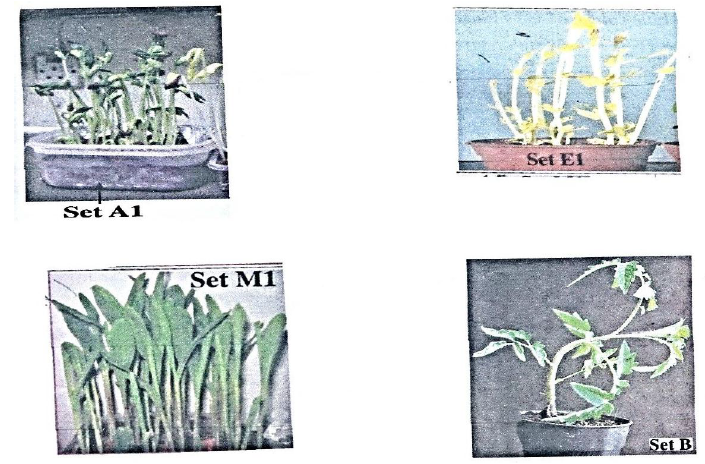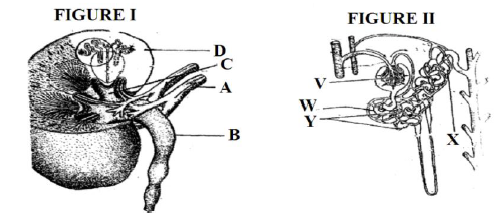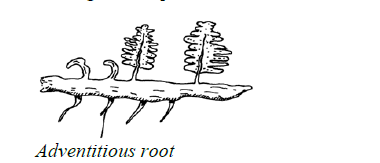a) - sclerenchyma;
- xylem;
- collenchyma;
b) i) X - biceps;
Y - triceps; 1mk
rej. flexor and extensor
ii) X (biceps) relaxes; as Y (triceps) contracts.
c) Hinge joint
sharon kalunda answered the question on September 17, 2019 at 05:53
- An experiment shown below was a set up to investigate a certain physiological process in plants.(Solved)
An experiment shown below was a set up to investigate a certain physiological process in plants.

a) What process was being investigated? (1 mark)
b) What effect will the following have on the observation made in (a) above?
i) Fanning the shoot
ii) Removing all the leaves from the shoot.
iii) Placing the set up in the dark.
Date posted: September 17, 2019. Answers (1)
- (a).Identify organs B and D in photograph T2 and state the class of organism from which they were obtained.(Solved)
(a).Identify organs B and D in photograph T2 and state the class of organism from which they were obtained.

(b) State the common function of the organs identified in (a) above.
(c) Name the parts of the body where B and D in photograph T2 are found
(d) List the adaptations of D to its functions
(e) Using observable features only, state how B is adapted to its function
Date posted: September 16, 2019. Answers (1)
- Photographs R1 and R2 show a certain response in plants.(Solved)
Photographs R1 and R2 show a certain response in plants.

a) Explain how the response shown above occurs.
b) What is the biological significance of the response shown by X?
Date posted: September 16, 2019. Answers (1)
- Examine photograph k 1and K2 then answer the questions that follow.(Solved)
Examine photograph k 1and K2 then answer the questions that follow.

(a) Name the response that is exhibited by the seedlings.
(b) Explain how the response you have stated in (a) above occurs.
(c) What is the significance (survival value) of the response you have stated in (a) above.
Date posted: September 16, 2019. Answers (1)
- The following diagram of a leaf shows what happens in a plant leaf during photosynthesis.(Solved)
The following diagram of a leaf shows what happens in a plant leaf during photosynthesis.

(a) State two ways in which leaves are adapted to absorb light.
(b) Name the gases labeled x and y.
(c) Name the tissues that transports:-
(i) Water into the leaf.
(ii) Sugar to other parts of the plant.
(d) Explain why it is an advantage for the plant to store carbohydrates as starch rather than as sugars.
Date posted: September 16, 2019. Answers (1)
- Study the following diagram showing longitudinal section of a kidney.(Solved)
Study the following diagram showing longitudinal section of a kidney.

Name the parts labeled A and B.
Date posted: September 16, 2019. Answers (1)
- Name the cavity formed by the scapula that form a joint with the humerous.(Solved)
Name the cavity formed by the scapula that form a joint with the humerous.
Date posted: September 16, 2019. Answers (1)
- Name two bones that form the pectoral girdle.(Solved)
Name two bones that form the pectoral girdle.
Date posted: September 16, 2019. Answers (1)
- The apparatus below illustrate breathing in a mammal.(Solved)
The apparatus below illustrate breathing in a mammal.

(a) Describe what happens if the rubber plug is pulled in the direction shown by the arrow.
(b) Give the parts of mammal represented by:-
(i) Capillarity tube.
(ii) Rubber plug.
Date posted: September 16, 2019. Answers (1)
- Give the name of the following responses.
(i) curvature of plant shoot towards light.
(ii) coiling of a plant shoot round a supporting structure.(Solved)
Give the name of the following responses.
(i) curvature of plant shoot towards light.
(ii) coiling of a plant shoot round a supporting structure.
Date posted: September 16, 2019. Answers (1)
- The following statement represents a type of gene mutation.(Solved)
The following statement represents a type of gene mutation.

(a) Identify the type of gene mutation illustrated in I and II above.
(b) Name two examples of chromosomal mutation that lead to change in chromosomal structure.
Date posted: September 16, 2019. Answers (1)
- Explain how dioecism prevent self-pollination(Solved)
Explain how dioecism prevent self-pollination
Date posted: September 16, 2019. Answers (1)
- Explain what happens when two species occupy the same habitat.(Solved)
Explain what happens when two species occupy the same habitat.
Date posted: September 16, 2019. Answers (1)
- A student observed a row of 16 epidermal cells in a microscopic field that was 8mm in diameter. Calculate the average length of each cell...(Solved)
A student observed a row of 16 epidermal cells in a microscopic field that was 8mm in diameter. Calculate the average length of each cell in micrometers.
Date posted: September 16, 2019. Answers (1)
- A scientific space craft brought some material to earth from the outer space. Explain how one would establish if the material is living or non-living.(Solved)
A scientific space craft brought some material to earth from the outer space. Explain how one would establish if the material is living or non-living.
Date posted: September 16, 2019. Answers (1)
- Study the diagrams set A1, set E1, set M1 and set B carefully and answer the questions below(Solved)
Study the diagrams set A1, set E1, set M1 and set B carefully and answer the questions below

(a) State the conditions under which each set up was grown.
Set A1
Set E1
Set B
(b) (i) Name the phenomenon exhibited by seedlings in set E1
(ii) Give a reason why plants exhibit the phenomenon named in (b) (i) above
(c) (i) Name the response exhibited by the seedlings in set B.
(ii) Explain how the response named in (c) (i) above occurred
(d) (i) State the type of germination exhibited by seedlings in set A1 and set M1.
Set A1
Set M1
(ii) Give a reason for your answer in (d) (i) above
Set A1
Set M1
(iii) State the mode of dispersal in set A above when mature.
(iv) Name the type of fruit formed by M1 on maturity.
Date posted: September 16, 2019. Answers (1)
- Study the kidney diagrams below:(Solved)
Study the kidney diagrams below:

a) i) Name the part labeled A in figure 1
ii) Name the process that takes place in the parts labeled V.
b) State two homeostatic functions of the organ in the diagram above.
c) Explain what will happen to the process of urine formation in absence of ADH.
Date posted: September 16, 2019. Answers (1)
- The diagram below represents three types of neurons found in a mammalian body.(Solved)
The diagram below represents three types of neurons found in a mammalian body.

(a) Name the neurons X, Y and Z
(b) Name the chemical substance responsible for the transmission of an impulse across the gap labelled W.
(c) State two functions of the part labelled M.
(d) In which part of the spinal cord is neurone Y located?
(e) Using arrows indicate on the diagrams the direction followed by nerve impulse leading to a response.
Date posted: September 16, 2019. Answers (1)
- Below is a diagram of a plant a form three student collected while carrying out an ecological study(Solved)
Below is a diagram of a plant a form three student collected while carrying out an ecological study

a) With reasons identify the division into which the students classified the plant.
b) (i) Name the structure that produces spores in this plant.
(ii) State two differences between the plant division above and that of the division spermatophyta.
c) Give two distinguishing features of class Amphibia
Date posted: September 16, 2019. Answers (1)
- Below is a diagram of a structure found in Eukaryotic cells. Study it and answer the questions that follow(Solved)
Below is a diagram of a structure found in Eukaryotic cells. Study it and answer the questions that follow

a) Identify the structure
b) State two functions of the structure
c) i) Name one organelle found in animal cells but absent in plant cells
ii) State one function of the organelle you have named in(c) i) above
Date posted: September 16, 2019. Answers (1)